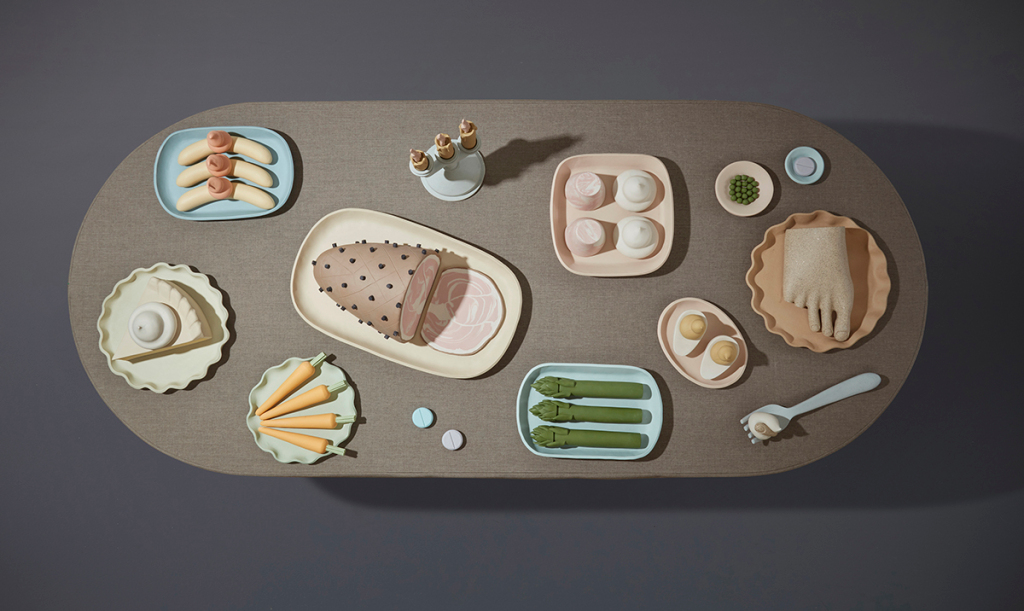ART NEWS
Genesis Belanger on Crafting American Consumption
Portrait of Genesis Belanger.
Courtesy the artist and Perrotin, New York. Photo Jillian Freyer.
On the surface Genesis Belanger’s works appear picture perfect, but on further inspection viewers might begin to notice a trumpet sticking out its tongue, an assortment of eyes and lips displayed in a chocolate box, or a desktop dispenser offering lengths of tongue rather than tape. Utilizing her background in prop-making for advertising campaigns, the Brooklyn-based sculptor anthropomorphizes common domestic items. Her porcelain, stoneware, and upholstery sculptures are often displayed in cheeky arrangements and installations that ask viewers to rethink their surroundings. In her latest exhibition “Through the Eye of a Needle,” which is currently on view at the Aldrich Contemporary Art Museum in Ridgefield, Connecticut, through May 9, Belanger draws on 1950s Americana for her forms and palette. She reimagines the remnants of a home through vignettes of covered household furniture and table setting for assorted meals, often gifted during times of hardship. As the coronavirus continues to ravage the United States, Belanger reflects on the relationship between American consumption and mourning.
Related Articles
When I first started thinking about this show, I was working out of my grandmother’s garage in Vermont. She’s 96 years old and had previously been living alone, but just started receiving part-time care. I realized that I was watching my mother and her five siblings go through this process of grieving the loss of my grandmother’s independence.
I started to reflect more broadly on our culture—how we treat people while they’re mourning and how we support them through their grief. Not specifically death, but any type of transition—even one that is positive—involves some mourning. We typically buy gifts and flowers, and cook meals to demonstrate care. It stood out to me that all of these gestures are based in consumption. They don’t feel emotionally supportive or genuinely empathetic. That brought me to the Biblical proverb, on which the title of the show is based, “It’s easier for a camel to go through the eye of a needle than for a rich person to enter the kingdom of God.” I thought the message really undercut this idea of purchasing emotional support.
View of Genesis Belanger’s exhibition “Through the Eye of a Needle,” 2020; at the Aldrich Contemporary Art Museum.
Courtesy the artist and Perrotin, New York. Photo Guillaume Ziccarelli.
When I made the sculpture A Fortress of Order and Generosity [2020], I was thinking how the odd assortment of food dishes brought to those who are grieving don’t quite fit together. I was simultaneously browsing images of food in cookbooks from the 1950s and ’60s—an era of American growth for which there is now great nostalgia. When we feel nostalgic, it’s because we think that there was a point in time that was better than this moment. Often, when I look through those images, I ask, “when was it great?” and “was this when it was great?” The dishes from the ‘50s and ‘60s look so formal and unappetizing.
I wanted to make a tablescape ordered on this duality between nostalgia and the uncanny. On the surface everything is seemingly perfect, but the oddities begin to emerge the longer you look. There’s something quite uncomfortable about the carrot or the cake being almost right. In other arrangements, I’m much more direct. There is a dish, for example, where a foot is placed among an assortment of food, which really captures the consumption of the corporeal.
Genesis Belanger: Naturally Groomed, 2020, stoneware, powder coated steel, porcelain, concrete, and brass ribbon; at the Aldrich Contemporary Art Museum, Ridgefield, Connecticut.
There are also pills scattered throughout, as has become common in my work. I graduated from high school in 1996, which was the year that OxyContin was introduced to the market. My younger brothers saw their classes decimated by heroin and other drug use throughout the opioid epidemic. We didn’t think much of it at the time. Now, knowing more about how the medical industry profited off of the sale of these addictive drugs, I see it as an undercurrent of our culture. I don’t know anyone who hasn’t been affected by it. Alternatively, the pills could also point to so many who have used medication to prolong their lives.
In each of my shows, I try to make a big formal move. Here, I made two extremely formal house plants. They’re a steel structure with big leaves that have little clumps of deflated ceramic balloons tied to the branches. They are quite different from a lot of my other work, but I’m very excited by their potential as well as the incorporation of steel, which is a new material for me.
Through my work, I’m continually trying to participate in a larger conversation about the construction of our surroundings and how we should question our assumptions. With the onslaught of Covid-19 and the US presidential election, these ideas of grief and empathy were pushed to the forefront of everyone’s minds. This show looks like a grand house that’s been closed for the season, and I think that’s a great metaphor for what we’ve collectively experienced this year. We will recover.
—As told to Francesca Aton











